Sharks:
 Sharks, the apex predator of the sea, you either love them or you hate them. Or you simply don’t care about them. Whether or not you love or hate them, sharks are important to the ecosystem and ocean life. Bio-diversity is important for the ocean’s ecosystem, and as apex predators, sharks help to maintain the food chain below them. Some sharks are known as “clean up crews” for the ocean. They take care of the weak and sick and keep the prey population healthy and in check. This ensures species diversity and a good diet for other sharks. Sharks do a lot for our oceans and world. Sharks are fascinating and generally misunderstood animals. In this article all about sharks, I will be listing some different breeds, some docile, and some not so much. Keep in mind, even if a shark is listed as docile, they are still animals and you are in THEIR territory. Do not swim with sharks unless with a professional.
Sharks, the apex predator of the sea, you either love them or you hate them. Or you simply don’t care about them. Whether or not you love or hate them, sharks are important to the ecosystem and ocean life. Bio-diversity is important for the ocean’s ecosystem, and as apex predators, sharks help to maintain the food chain below them. Some sharks are known as “clean up crews” for the ocean. They take care of the weak and sick and keep the prey population healthy and in check. This ensures species diversity and a good diet for other sharks. Sharks do a lot for our oceans and world. Sharks are fascinating and generally misunderstood animals. In this article all about sharks, I will be listing some different breeds, some docile, and some not so much. Keep in mind, even if a shark is listed as docile, they are still animals and you are in THEIR territory. Do not swim with sharks unless with a professional.
LEMON SHARK
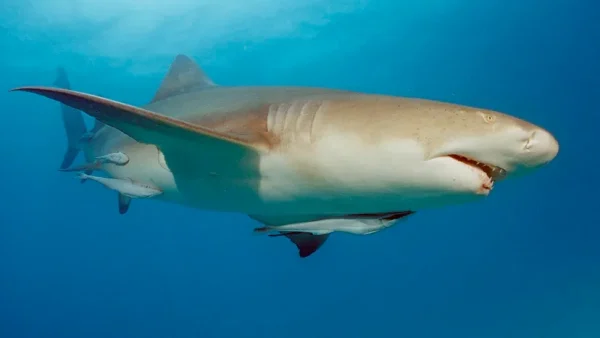
Lemon sharks are not considered much of a threat to swimmers or divers. They are actually very docile, curious and social sharks. There have even been documented cases of Lemon Sharks forming bonds with divers and seeking affection such as Blondie the shark. Even in some cases of Lemon sharks favoring certain divers enough to get jealous when another shark tries to receive affection from that diver. Because of this docile behavior, Lemon sharks are often studied because of how well they do in captivity. This gives scientists a lot of freedom to study these sharks and their social behavior. It’s been found that Lemon sharks make friends, have their own personalities and even use body language to communicate. For how friendly this shark is, you’d be surprised to know this isn’t the friendliest breed of all. It’s not even in the top 5 friendliest of shark breeds! 10 unprovoked Lemon shark attacks have been reported from Florida and the Caribbean. None of these attacks were fatal and were just bites. Although many people swim with Lemon sharks and they are very docile, those reports just show that these sharks are still animals that they are not easily tamed.
These sharks can be recognized for their brown, or yellowish skin. They average at 8-10 feet and can weigh up to 220 lbs.
Shark Demands Hugs Whenever She Sees Her Diver Friends
NURSE SHARK

Nurse sharks are yet another very docile and friendly breed. They are bottom dwellers and nocturnal creatures. Unlike the social and friendly Lemon shark, Nurse sharks are usually either sleeping when divers come down, or they swim away upon seeing swimmers and divers approach. They are docile, but would rather sleep or avoid interactions with humans all together. They stay in groups with one another and are relatively chill. These sharks can be found in warm coastal waters, Atlantic and Eastern Pacific. As mentioned earlier, sharks help with the marine ecosystem and the Nurse sharks are part of the “clean up” crew group. They have a strong jaw force because their diet consists of crustaceans, mollusks and small very bony fish. These sharks are ranked fourth in documented shark bites despite their docile and calm nature. This is where sharks as an entire species begin to become misunderstood. This shark breed would rather sleep than interact with swimmers or divers, and they ONLY attack if provoked. You are not on their diet and usually, they really have no interest in eating a meaty human. Because they are one of the breeds that people swim with the most, that equals more provoked attacks. They are bottom dwellers and sometimes people don’t look where they are stepping or they think because it’s docile shark, they can touch the shark however they please. All these instances lead to the calm shark, which is half asleep, feeling threatened and ready to attack. This leads to many attacks. More than half of these attacks are not fatal and are only bites. These sharks are simply defending themselves. Unfortunately, the Nurse shark is on the endangered species list.
Nurse shark tail fins can be up to one fourth of their body size, they are commonly a dark camouflage brown with white eyes. They also have small “whiskers” known as barbels. This helps the shark touch and taste, which aids them when hunting.
SAND TIGER SHARK
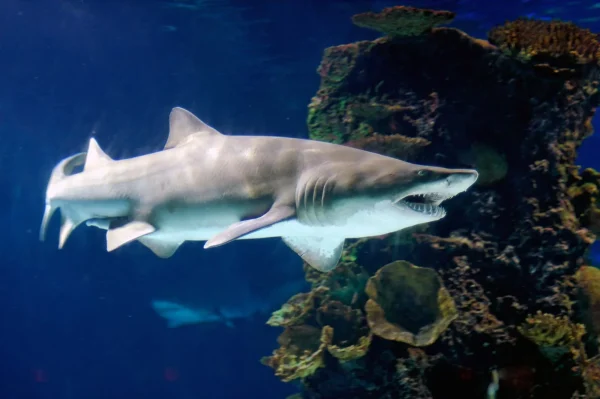
These sharks are easily recognizable, they can reach lengths up to ten feet, they have pointed conical snouts and their teeth protrude, which can make them look extremely intimidating. But despite their fearsome appearance, these sharks are placid and slow-moving. They also have no documented fatalities with humans nor many unprovoked attacks. These sharks are also part of the Nurse shark family, which makes them docile as well, unless threatened. Noticing a pattern? Many sharks are extremely misunderstood. Although you should definitely not stop to pet one if encountered, many people turn a blind eye to the rapid increase in shark hunting. This specific shark breed is often hunted for their fins and liver oil. Sand Tiger sharks reproduction systems do not help their current level of endangerment. Intrauterine cannibalism is a reproductive system where the largest embryos will eat the other smaller and weaker ones, which usually results in the female only giving birth to two or three pups, or in the worst case scenario, one. This shark species is currently critically endangered. If nothing changes, soon these sharks will only be alive in aquariums. This will affect the marine ecosystem since this breed of shark aids in keeping crustaceans, bony fish and small shark populations healthy.
These sharks are beautiful and fascinating. It would be devastating to see them go.
GREAT WHITE SHARK
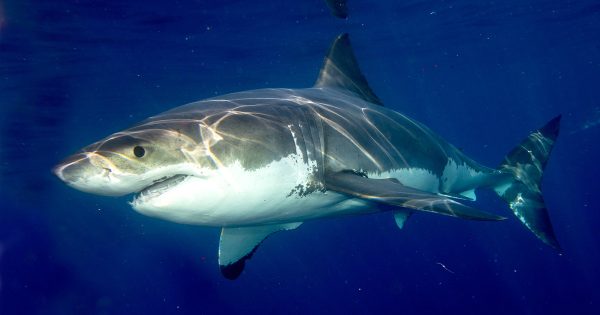
The famous Great White shark. The main star in Jaws and, for the most part, the reason why sharks have a bad wrap. There is no sugar coating this, Great White sharks are dangerous and aggressive. There is no redirecting them or playing dead. If you swim away and they’re hungry, they will get you. If you try to swim, they will probably still get you. Once again, I am here to defend this behavior. An extremely large predator is dangerous. Great White sharks, much like any other shark breed, do not have humans on their diet. Oftentimes, there are two main reasons for unprovoked Great White shark attacks. The shark is curious and they bite. They do not have hands, so they bite to get a sense of what something is. Due to how strong a Great White shark is, one bite can be fatal. It is often documented that a Great White shark will only bite once and then retreat and not come back. Secondly, these sharks being as big as they are, feed off much larger predators unlike the other sharks listed above. Seals, sea lions and other large sharks are on the Great White sharks diet. Even with their keen eyesight, they may just mistake you as food. If you are encountering a Great White shark in the first place, the odds are you are in their feeding territory. Even the largest, most dangerous sharks can be misunderstood.
As for their well known appearance, Great White sharks have a short snout, they are large with a triangular shape head. They have serrated teeth and their skin is gray, or brown. With that well known under-belly. Males can grow to be 11-13 ft, while females can be up to 16 ft! This breed can weigh up to an impressive 2,400 lbs.

BASKING SHARK
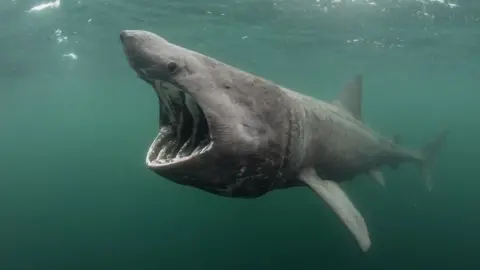
This is the second largest shark breed, reaching as long as 36 ft, and has a lifespan of 50 years. Despite their horrifying looks, this sharks diet only consists of plankton. This make’s them a very little threat to humans. The shark is gray-brown or blackish, with tiny teeth and large gill slits. But their most prominent feature is definitely their wide gaping mouth. This shark feeds off plankton, cape-pods and other zooplankton. In order to eat enough for its size, this shark keeps its jaw wide open to catch these plankton as it swims all day. This shark is also known as a cosmopolitan migratory species. Surprisingly enough, even with this shark’s huge size and docile behavior, not much is really known about them. There have been zero fatalities or attacks against humans with this breed.

Fun fact about these gentle giants: they are likely the foundation for many sea monster myths we know today! Many “sea monster” corpses that have been reported to be beached on shore, were in fact basking shark corpses.
THRESHER SHARK
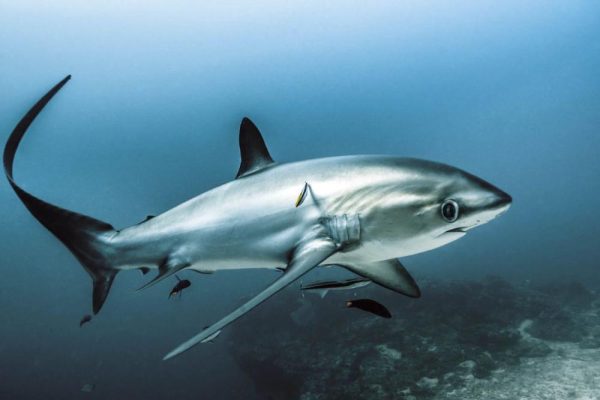
This breed of shark is easily recognizable for one very unique feature: their scythe-like tail. One part of the Thresher shark’s tail is extremely large compared to the bottom; this large tail usually grows to be the size of the shark’s entire body! This unique feature is an evolutionary adaptation to aid in hunting due to the shark’s facial structure. Although a rather large shark, the facial shape of this species can make it difficult for them to kill prey with jaw power alone. Unlike the great white shark, whose bite force can instantly kill, the Thresher shark relies on its large tail to herd schools of fish and stun them. They slap their tails at the surface of the water, creating a stunning effect on the school of fish, making it easy for the shark to then catch its prey with its tiny teeth. Although many images of this shark can make them seem small, this is just an optical illusion. Due to the size of their tail being the same length as their body, they can appear small. But this species is one of the largest, measuring up to 20 ft in length and weighing in at 1,100+ pounds. Thresher sharks come in a variety of colors, such as brown, gray, blue-gray, or even in a blackish tint.
There has only ever been one reported attack by this breed, and it was provoked. A diver attempted to grab a Thresher shark’s tail, resulting in him getting whacked and bitten. Fortunately, this attack was not fatal to the diver. Like many other shark species, Thresher sharks are generally harmless. They are difficult to approach and usually avoid interaction, and when they do, they have been reported as “very timid”.
Because of their large tail, this breed is hunted for sport and for their liver oil. Due to their depleting number in population, there are now laws intact to protect them.
HAMMERHEAD SHARK
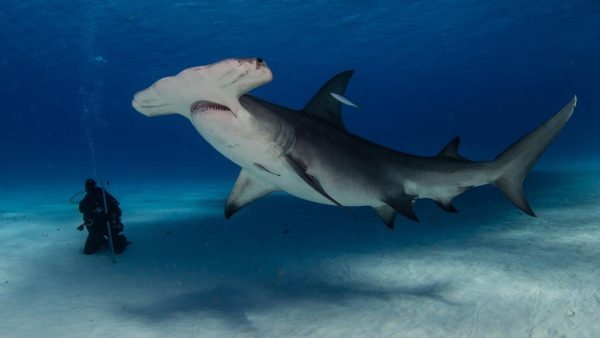
These sharks are recognized for their “hammer-like” head shape, also known as cephalofoil. This unique head shape provides several advantages to this breed, including improved vision, enhanced electroreception (the ability to sense electric fields), and increased agility in the water. There are four species of Hammerhead sharks, and their size varies depending on the species. Some hammerheads only reach up to 4 ft, while others can grow up to 20 ft. Hammerhead sharks are highly social and often swim in schools that can consist of hundreds or even thousands of individuals. While this behavior aids in hunting, reproduction, and other factors, it also makes them vulnerable to hunters. Over fishing and habitat loss pose significant threats to this species, which is currently considered vulnerable. Their slow reproduction rate is a concern, but Hammerhead pups are born with hunting instincts, providing a slight advantage to their declining population. However, if their habitat continues to be lost and over fishing persists, this advantage may diminish, potentially leading to the species becoming endangered or even extinct.
Although aggressive hunters, Hammerhead sharks are not much of a threat to humans. There have been 16 recorded attacks yet none were fatal. Though labeled as non-threat, these sharks can be defensive and territorial and it is usually not recommended for divers or swimmers to willingly swim with them.
WHALE SHARK

Another very well-known and recognizable shark, but unlike the famous Great White shark, is the Whale shark. Starring in children’s movies such as Finding Dory, this breed of shark most definitely is deserving of this title of gentle giant. This is the biggest breed of shark, weighing in over 34 metric tons and averaging the length of 59 ft! Despite their massive size, this is the #1 friendliest shark breed in the world, as they pose almost zero threat to humans. Similar to the Basking shark, Whale sharks are filter feeders and consume plankton, small fish and invertebrates by opening their mouth and allowing their prey to get sucked right in. This friendly shark would never think to intentionally harm any human, and they do not mind human interaction and have become accustomed to it.
Much like a human fingerprint, Whale sharks have their own unique pattern of spots. Each Whale shark has their very own pattern and this can easily help scientists and divers be able to recognize individual Whale sharks. They have broad and flattened heads, large tail fins and mouths that can be around 5 ft. This shark breed is stunning as well, which has helped with its reputation. These sharks come in gorgeous blues and grays, sometimes brown, with beautiful white spots that adorn their body and tail.
This breed of shark is currently listed as endangered despite their ability to birth around 300 pups at once. Fisheries, climate change, tourism, and fining all being just a handful of threats to whale sharks.
Fin (pun intended)
While this marine animal remains dangerous, I believe their reputation can be redeemed. Like sea turtles and whales, they deserve protection and support. Unfortunately, they are highly misunderstood and often demonized in media and film. These creatures are being hunted, and many species are now listed as “vulnerable”. By sharing information about these species and presenting statistics, we can help to showcase their normal behavior and defensive nature. I hope that by reading this article, some people will feel inspired to make a change.
Works cited
Ebert, David. “Lemon Shark.” Save Our Seas Foundation, saveourseas.com/worldofsharks/species/lemon-shark.
“Ginglymostoma Cirratum.” Florida Museum, 9 May 2017, www.floridamuseum.ufl.edu/discover-fish/species-profiles/ginglymostoma-cirratum/.
“Global Protection of Endangered Sharks!” Shark.swiss, 15 May 2020, shark.swiss/. Morgan, Alexia. “Negaprion Brevirostris.” Discover Fishes, 8 Oct. 2018, www.floridamuseum.ufl.edu/discover-fish/species-profiles/negaprion-brevirostris/#:~:text=Lemon%20sharks%20represent%20little%20threat
“Whale Sharks.” Google.com, 2024, www.google.com/url?sa=t&source=web&rct=j&opi=89978449&url=www.worldwildlife.org/species/whale-shark&ved=2ahUKEwjPj6e4htWFAxXF5MkDHW3sDm0QFnoECCsQAQ&usg=AOvVaw3Ib5HSAJkK1iFrESkT99Oa. Accessed 22 Apr. 2024.
Google.com, 2024,https://www.google.com/url?sa=t&source=web&rct=j&opi=89978449&url=https://www.worldwildlife.org/species/whale-shark&ved=2ahUKEwjPj6e4htWFAxXF5MkDHW3sDm0QFnoECCsQAQ&usg=AOvVaw3Ib5HSAJkK1iFrESkT99Oa Accessed 22 Apr. 2024.




















